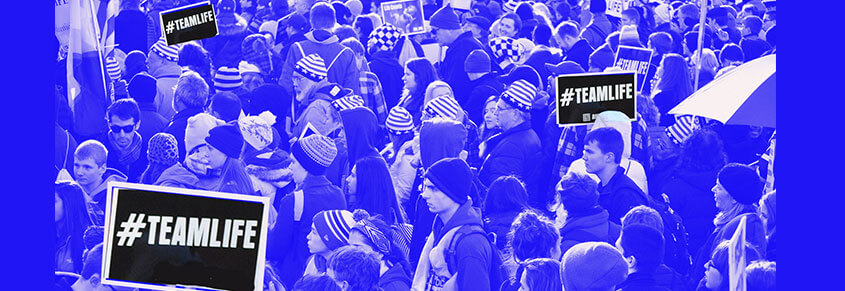

Franciscans of the Immaculate/ CC 2.0
Abortion Rights
Franciscans of the Immaculate/ CC 2.0
The Anti-Abortion Movement Is Killing It on Twitter
Abortion opponents use the social media platform like a weapon, and with absolute precision—and they're winning as a result. What are pro-choicers doing wrong?
This article was made possible because of the generous support of DAME members. We urgently need your help to keep publishing. Will you contribute just $5 a month to support our journalism?
This is the first installation in our five-part series about our hate-love-hate relationship with Twitter, which has become a powerful means to organize, disseminate information, engage in dialogue … and troll, stalk, harass, and quite possibly start wars. Access Denied columnist Robin Marty inaugurates the series with a look at the way the anti-abortion movement has found in the social-media platform one of its most effective megaphones.
I don’t think a week goes by where I don’t have a picture of a bloody fetus popping into my Twitter mentions. Sometimes it is from an abortion opponent from Colorado that I met once at a protest—it’s sort of her way of saying “hi.” More often it’s from people who stumble across an article I’ve just written about upcoming bills or new threats to access, usually after my piece is shared by reproductive rights groups or individual advocates. I’m not usually the target, more like collateral damage as the twitter persona lobs graphic images at NARAL, Planned Parenthood, or whomever tweeted it in the first place.
Those tiny feet or transparent fingers honestly don’t have much impact on me anymore, and I’m pretty much desensitized to people asking me why I like to kill babies. Like most people who write about reproductive rights, I’ve become so used to being attacked by those who disagree with me that their harassment usually doesn’t even register.
But those people—although they may be against abortion and on Twitter (or, even more likely, many of them may just like the opportunity to harass women online)—aren’t truly representative of anti-abortion Twitter. When it comes to the movement itself, it is a coordinated, well-oiled machine that uses Twitter with absolute precision.
And honestly, they are kicking our asses every time they do it.
From turning the trial of Kermit Gosnell from a local crime story to a national rallying cry against dangerous rogue abortion providers to forcing Planned Parenthood into instant crisis mode within moments of the first so-called “baby parts” videos hitting the internet, the anti-abortion movement doesn’t just use social media as a highly effective tool: It is a literal weapon in their hands. Over the last few years, the movement has successfully trended hashtag after hashtag, using them to push media coverage on Supreme Court cases, abortion bans, even bubbles of mainstream news coverage of the annual March for Life.
We saw the latest example just this week when activists took to the platform to complain about its own refusal to allow Tennessee Rep. Marsha Blackburn, a key Congressional abortion opponent, to pay to promote a tweet with an ad announcing her Senate run. Twitter denied the paid placement because the ad contained an unsubstantiated claim regarding Planned Parenthood’s “sale of baby body parts,” which it deemed inflammatory. Within one day of Twitter activism, Blackburn’s video received far more attention than it ever could have obtained via a paid promotion. Then, in the end, Twitter caved to public pressure from activists and reversed its own decision, allowing Blackburn to promote the tweet.
Anti-abortion activism on Twitter has been highly successful in many of the cases where it is attempting to steer media coverage to promote pro-life views. It urged reporters into the courtroom at the 2013 Gosnell trial, despite days of empty seats until a “tweetstorm” launched, and nabbed more mainstream media coverage for the March for Life this year than for any previous year’s march, primarily by calling out news outlets and demanding they pay as much attention to the pro-life march as they did to the Women’s March on Washington less than a week earlier.
But how exactly are they so good at this? I decided just to ask.
“One of the most strategic ways I use Twitter is to check in on what’s trending, if there’s a hook we can grab onto today,” Matt Yonke told me. Yonke, the assistant Communications Director of Pro-Life Action League, shared how he often checks the trending hashtags in order to find ones that could have a pro-life message inserted inside of it—like, for example, #beststoryin5words, a recent tag where he and others tweeted things like “We are keeping the baby #beststoryin5words” or other positive anti-abortion sentiments.
Yonke primarily uses the Pro-Life Action League Facebook page—which has a much larger following than its Twitter account—as a springboard for Twitter activism. A post on the Facebook page will tell that audience to head to Twitter with suggestions of a hashtag to tweet and potential language to use, providing direction and an easy action item for fans.
To Yonke, inserting anti-abortion messages into secular, unrelated trending topics is less about conversion or even conversation, but more a chance to remind people at every level that abortion is a part of the culture and that it is everywhere and cannot be avoided or ignored. “There’s a little bit of subversion there,” he said. “We are trying to make people think about abortion when they don’t want to, because nobody wants to think about abortion, ever. We turn the conversation towards the issue.”
While Yonke may call his approach more “scatter-shot,” Bryan Kemper is far more deliberate in his own Twitter messaging. Founder of Stand True Ministry, the youth outreach arm of Priests for Life, Kemper’s Twitter game is as aggressive and strategic as the man himself. If you’ve ever seen a pro-choice hashtag overtaken by anti-abortion tweets, odds are Kemper was behind it.
“You guys kick our asses on Twitter, over and over again,” I said to Kemper.
“Yeah,” he laughed, “That’s kind of been my specialty.”
Kemper said there are a variety of reasons that the anti-abortion movement is so effective—and especially so much more effective than the abortion-rights movement—on Twitter. According to Kemper they have far more younger activists in their base, which gives them more social media power, and they also benefit from having so many stay-at-home mothers and grandmothers who aren’t working and who can be ready to hit Twitter with a message when asked. “We have a base of these people, and this base got built up during Gosnell and they loved it and they love using Twitter now to do this kind of stuff,” he said.
But while they are good at building campaigns and raising awareness on Twitter, this Twitter army is even better at what he calls “Twitter takeovers”—the hijacking of a hashtag being used by their opponents, which they will then flood with their own anti-abortion messages. “In Texas, they tried to have one of their local politicians and abortion providers do a live tweet event, and they were going to answer people’s questions,” Kemper explained. “Basically 90 percent of what came in was all from pro-lifers. We took over the hashtag.”
What it all boils down to is that what really makes the anti-abortion movement’s Twitter campaigns (or Twitter derailing campaigns) so successful is that their leaders all work cohesively together across the boards on them, turning several groups into one large social media unit. “We are able to network with each other so quickly that we can get everyone on board at the same time,” Kemper said. “I could make a phone call to Kristan Hawkins at Students for Life, a phone call to SBA List, and a phone call to this and I can have that many groups instantly getting to their people, ‘We’re going to take over that hashtag,’ and it works. Because we have a well-organized communication strategy when it comes to this kind of activism.”
It’s a cohesion that is often lacking in the world of pro-abortion rights activists, and one that is probably unlikely to ever exist. In the end, our failures aren’t due to a smaller base, or less enthusiasm, or even the “barrier” of women who work outside of the home, but simply because despite over half a century of activism, we still remain largely factionalized.
One of the anti-abortion movement’s biggest successes is its ability to be the loudest voice in the room, despite the fact that for most of the last two decades more Americans have identified as pro-choice than as pro-life. Their social media prowess has allowed that voice to become even louder, both in pushing their own talking points and shutting down the voices that disagree. It’s no wonder that they are so enamored of Twitter, which provides the biggest megaphone to those who are the most organized, aggressive, and persistent.
It’s a lesson the abortion-rights movement could stand to learn a little from themselves.
Before you go, we hope you’ll consider supporting DAME’s journalism.
Today, just tiny number of corporations and billionaire owners are in control the news we watch and read. That influence shapes our culture and our understanding of the world. But at DAME, we serve as a counterbalance by doing things differently. We’re reader funded, which means our only agenda is to serve our readers. No both sides, no false equivalencies, no billionaire interests. Just our mission to publish the information and reporting that help you navigate the most complex issues we face.
But to keep publishing, stay independent and paywall free for all, we urgently need more support. During our Spring Membership drive, we hope you’ll join the community helping to build a more equitable media landscape with a monthly membership of just $5.00 per month or one-time gift in any amount.




















































































